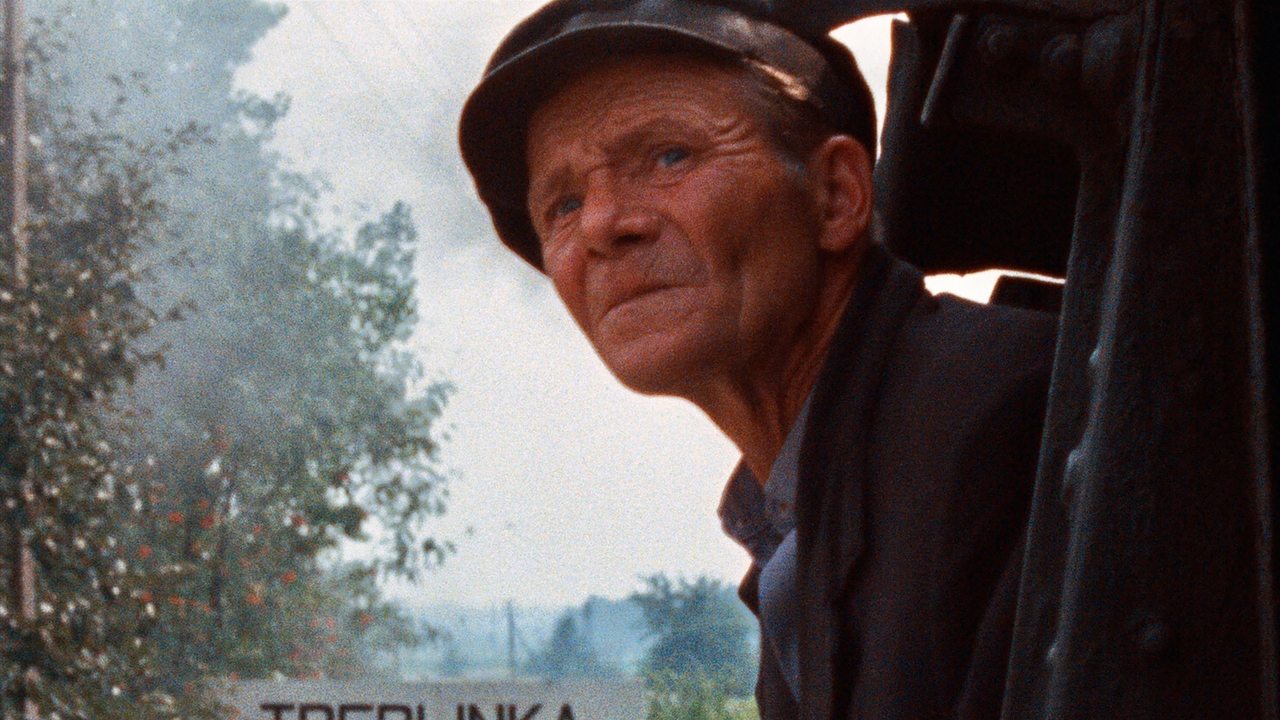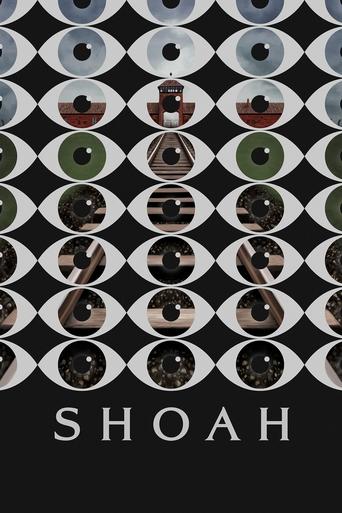

One reason why I'm drawn into cinema is that at its best it brings together all of art, transcends the boundaries, and without which I would be somehow clueless, somewhat not completely myself. Almost always I describe these films as important, subjectively speaking, and most of the time the mark they imprint upon me is a thirst for more, all this in the most positive sense one may imagine.And then there's "Shoah" (1985). It's unbearably long, gruesomely shocking and depressing, and with certainty a film I don't wish to see again and see as a kind of anti-film. Yet that's precisely why it's remarkable, and why it is important. It's transcendental in a way that I've rarely witnessed: it disregards time and its own format, and simply exists. It doesn't care that it stops and meditates. To "linger" is a wrong choice of words, since it means staying in one place "longer than necessary, typically because of a reluctance to leave". The point is not to linger, but to endure. The point of the film is to exist as it is, as a witness. Thus one of its weaknesses, if one uses such comparative and charged term, becomes its essential characteristic: the film is all about not being a film, it's not about finding a quick way around a point to another. It's a record of pain, and it's not meant to be an easy-going experience."Shoah", then, is like a film that refuses to be a film. It was Ebert who called it "an act of witness". I agree. It is a witness to people reminiscing about something so horrible of which it's quite impossible to reminisce at all. But they do it, and their pain has been transferred to Lanzmann's poem. This poem doesn't try to make the incomprehensible comprehensible, but rather make that, which is incomprehensible to them, the survivors, equally incomprehensible to us. As such, "Shoah" is a monument, a collection of recollections that wrenches at the heart.I suppose my reaction was the most natural there is after being exposed to what the Holocaust was: emptiness that is like a fleeing dream trying to catch its tail, unsuccessfully groping at the ever-distant memory. The feeling is that there was no way out, and there still isn't. That we can learn from the horrors of the past, but really don't. And at what cost? The survivors' testimonies, of their own survival and of the lives of those who didn't, is, in the end, the story that deserves to be told, again and again.I saw "For All Mankind" (1989) shortly after this. I'd say these two films form a very perceptive cross-section of what we humans are like. The awe I felt during "Mankind" only intensified the opposite kind of awe, of dread, I felt during "Shoah": can this be the same humankind that is capable of both kinds of deeds, and almost contemporarily? No matter how far into space we launch ourselves, we carry within us both the darkness and the light, the hopelessness and hope. In the words of W. B. Yeats, "things fall apart; the centre cannot hold."
... View MoreFrench professor, film editor and director Claude Lanzmann's second documentary feature which he made during eleven years of travelling around the world and conducting 350 hours of interviews with survivors of the Second World War, premiered in France in 1985, was screened in the Forum section at the 35th Berlin International Film Festival in 1986, was shot on locations in Poland, Germany, USA, Greece, Switzerland, Israel and is a French production which was produced by Claude Lanzmann. It tells the story about the construction of the extermination camps in Chelmno, Belzec, Auschwitz, Treblinka, Sobibor in Poland and Vilna in Lithuania, the specific reasons for why they were built, how they were used, what the conditions were like within them, who they were made for, the undressing rooms, crematoriums and gas chambers within them, the infirmary, the gas vans, the SS men who ruled and carried out the "procedures" there and the Jews from Poland, Bulgaria, Belgium, the Netherlands, Hungary, Greece, Czechoslovakia, France who, in large groups, were placed on and transported with death trains to places where those lights of life and love whose ancestors going back as far as to the 4th century had been told by Christian missionaries that they could not live among them as Jews, by secular leaders of the middle ages that they could not live among them and then by 20th century Nazis that they could not live, were scorned and systematically put where civilized human beings puts lifeless things. Distinctly and subtly directed by French filmmaker Claude Lanzmann, this quietly paced documentary which is narrated from multiple viewpoints, through letters read by Claude Lanzmann and translated by Francine Kaufmann, Madame Apfelbaum and Barbara Janica, draws a clarifying and dignified portrayal of the few, compared to the "many" who were murdered, survivors who passed through the gates that led them to life. While notable for it's naturalistic and variegated milieu depictions, distinct cinematography by French cinematographers Jimmy Glasberg, Dominique Chapuis and William Lubtchansky and use of sound, this interview-driven and narrative-driven retrospection and invaluable document of history which underlines the importance of documentary filmmaking, examines how paramilitaries called the Schutzstaffel, under the command of their Nazi ideological leader, almost succeeded in their calculated attempt at slaughtering and burning a whole population down into ashes, the experiences of those who were assigned to "work" in the death camps, the relations between the Poles and the Jews before, during and after World War II (1939-1945), the conditions in the European ghettos in Poland, former Soviet Union, Lithuania, Hungary and the German bureaucracy which managed the ghettos, presents an educational depiction of the anti-Semitic, national-socialist-driven, misanthropic, cowardice and heartless genocide of Jews which took place more than seven decades ago, and which is described so graphically and with so much excruciating strive by men and women who were deprived of all their human dignity and by some who either truly supported the Nazi Party or did so thinking that they might be killed if they did not, that it surpasses any form of visual representation. This logical, open-minded, multi-lingual and conversational epic from the mid-1980s about harrowing human suffering which is set in North America, Asia and mostly in Europe in the late 1970s and early 1980s, which goes on a voyage into the footsteps of the Jewish people which lasts close to nine hours and which contains interviews with villagers from Chelmno and Treblinka in Poland, Grabow in Germany, Corfu in Greece and some thirty-seven interviewees, is impelled and reinforced by it's cogent narrative structure, subtle continuity, scenes of mass murder sites and graveyards which in their silent emptiness has quivering effect, a former train-driver on a train to Treblinka who makes a sign he and others were greeted with by a farmhand when they arrived there and were headed for the concentration camps, poignant scenes of railways and trains, the comments : "It is one thing to know about statistics." and "Perhaps it will shake the conscious of the world." and the remarkably efficient interviewing approach where it at times is like hearing an intelligent child asking : "When was it?, where was it?, what was it like?, what happened there?, why did it happen? A work of art, a stately warning to future generations, an eternalised record of history, an echoing anti-war statement and an unforgettable testimonial of real events which commendably articulates and envisages grand-scale crimes against humanity through the voices of the people who were there, who witnessed it, who lived it and who survived it.
... View Moredespite my deep interest in the Shoah, I could watch only part of the movie. I was too disgusted by the morbidity by which the interviewer (the director himself) ask the most minute, excruciating, terrible details to the survivors, like "which members of your family died? how did you recognize their corpse when you dug out their bodies from the common graves?". And the interviewee eyes are filled with tears, and the camera steady on close up to show well his expression of pain. I found all this too filthy, this is voyeurism, it inflicts too much pain in those poor people, without bringing any benefit from an historical perspective. I bet that most interviewees had nightmares for weeks after these kind of interviews. And the movie is boring and technically very elementary.
... View MoreClaude Lanzmann's nine-hour Holocaust documentary is difficult, painful, and, above all else, exhausting – both emotionally and physically. I watched this goliath over four nights, and I pretty much had to force myself into every viewing, knowingly condemning myself to two hours of misery. But I wouldn't trade the experience. There are movies, and then there are... well, there are no words for what this is. Lanzmann spent six years tracking down and interviewing Jewish survivors, German commanders, and Polish eye-witnesses, reconstructing through oral testimonies – without even a second of archival footage – the horror of the Nazi death camps. The dialogue, often interminably filtered through an interpreter and then translated from French via subtitles, is overlaid on footage of the death camps as they stand now (that is, in the 1970s/80s), as innocuous ruins or grassy fields. Thus, Lanzmann juxtaposes the atrocities described in his interviews with the quietude of the modern-day locations, acknowledging from the outset the impossibility of ever fully recreating or appreciating the horrors that took place.Throughout the film, we mostly perceive Lanzmann as an off-camera interviewer, but he nevertheless takes a very active role in the film's presentation. We note his determination to assemble a historical record at all costs: he includes footage of himself assuring Franz Suchomel, a former SS officer, that the interview is not being filmed. (Many alleged perpetrators are seen only through a grainy black-and-white hidden camera, a device that keeps them emotionally distant from the viewer, as in a 1940s newsreel). Lanzmann rather sardonically asks his interpreter to complement a German couple on their beautiful home, knowing full well that it once belonged to a Jewish family.The interviews with Jewish survivors are most haunting of all. Lanzmann doesn't ask them to communicate their emotions, but instead needles them for details, seemingly inconsequential observations that nevertheless improve our understanding of how the Final Solution operated. But he also knows when to keep quiet. The silent anguish evident on the survivors' old, scarred faces is often more powerful than words could ever be. One survivor of the Warsaw Uprising remarks to Lanzmann, "if you could lick my heart, it would poison you." We can see this even in his face.
... View More